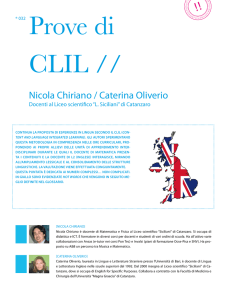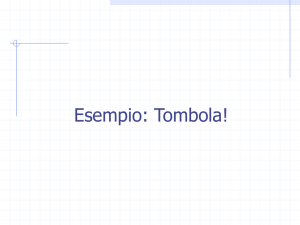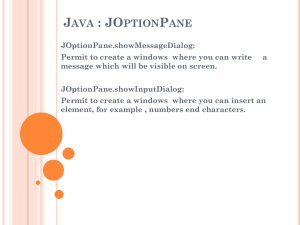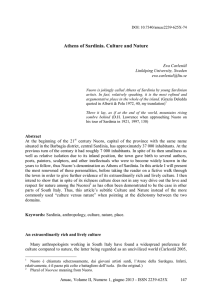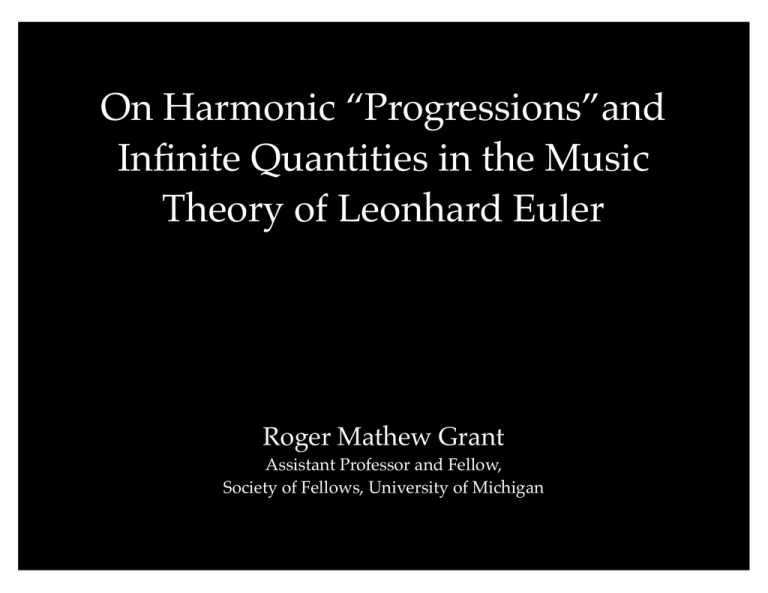
On Harmonic “Progressions”and
Infinite Quantities in the Music
Theory of Leonhard Euler
Roger Mathew Grant
Assistant Professor and Fellow,
Society of Fellows, University of Michigan
Leonhard Euler
(1707–1783)
Coincidence Theories of Consonance
2:3
1:1
Coincidence Theories of Consonance
1585
1619 1636
Benedetti Kepler Mersenne
1739
Euler
I. Coincidence Theories of Consonance
II. Euler on Infinite “Progressions”
III. Euler’s Historiography of Music Theory
IV. Euler and the Future of Musical Thought
The Harmonic Series
1 : 2 : 3 : 4 : 5 : 6 : 7 : 8 : 9 : 10 : 11 : 12: 13: 14: 15: 16
2:3
1:1
Coincidence Theories of Consonance
1585
1619 1636
Benedetti Kepler Mersenne
1692
1739
Euler
Boethian Quadrivium
Continuous
Discrete
Geometry
Arithmetic
Astronomy
Music
Gioseffo Zarlino
Le istitutioni harmoniche (1558)
“Number is a multitude composed of many Ones”
Il Numero essere moltitudine composta di più unità
“One is not a number, though it is the origin of number”
La quale unità ben che non sia numero, tuttavia è del numero
“The unison is only the origin of consonance or of
interval; but it is neither a consonance nor an interval”
l’Unisono è solamente principio della consonanza, o dell’Intervallo ma
non è consonanza, ne intervallo
Reception of Algebra
François Viète
Reception of Algebra
Continuous
Discrete
Variables
Variables
Reception of Algebra
Simon Stevin
Marin Mersenne
Harmonie universelle (1637)
1:1 2:1 3:1 4:1 5:1 6:1
8:1 9:1 10:1
12:1
15:1 16:1
Nature…prefers to break up the series of its intervals and
melodies, rather than passing through an interval which
will only hurt the ear and mind.
La nature qui est harmonique, la reiette & ayme mieux romper la suite de ses
intervalles & de ses chansons, que de passer par un interval qui ne vaut rien,
que pour blesser l’oreille & l’esprit.
720 360 240 180 144 120 100 90
80
1⁄ 1⁄ 1⁄ 1⁄ 1⁄ 1⁄ 1⁄ 1⁄ …
1 2 3 4 5 6 7 8
72
67.5 60
in infinitum
Francis Robartes
(1692)
54
50
48
45
Coincidence Theories of Consonance
1585
1619 1636
Benedetti Kepler Mersenne
1692
1739
Euler
II. Euler on Infinite “Progressions”
III. Euler’s Historiography of Music Theory
4:7
Johann Philipp Kirnberger
Flute Sonata in G Major (1769)
Johann Philipp Kirnberger
Clavierübungen (1766)
I count the ratio 4:7 among the consonant
intervals; it exists as certainly as 1:2... We know
that one of the greatest scholars of our times,
Leonhard Euler, has written about this ratio.
IV. Euler on the Future of Musical Thought
Fontenelle, “Sur l’application des sons harmoniques
aux jeux d’orgues” (1742)
This new consideration of the relationship of sounds is
not only more natural because it is none other than the same
series of numbers that are multiples of unity, but also
because it conveys and represents all the music and the
only music that nature gives to us by itself without the
aid of art… It therefore seems that every time nature
makes by itself, so to speak, a system of music, she does
not employ anything but this species of sounds—
however, they have remained, until the present,
unknown in the theory of the musicians.
Condillac, La langue des calculs (c. 1780)
Here is the advantage that algebra will
have: it will allow us to speak like nature.
Condillac,
on the development of a mathematical philosophy:
The characteristic of [mathematical] analysis is to
lead us by the best, the simplest, and the shortest
method.
This analysis is not one science
separated from all others. It belongs to them all
—it is their true method, their soul. I will call
this analysis metaphysics, provided you do not
confuse it with the first science of Aristotle.
Roger Mathew Grant
[email protected]
Assistant Professor and Fellow,
Society of Fellows, University of Michigan

